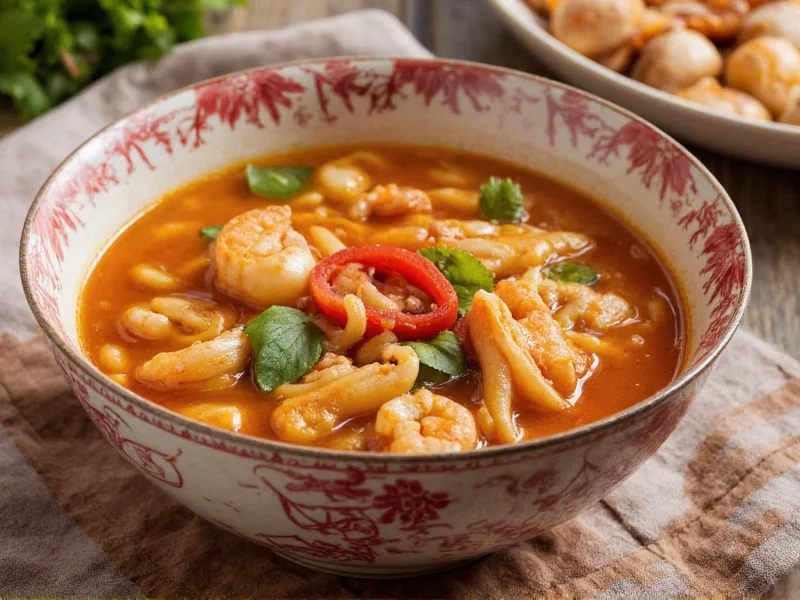Understanding the precise calories in a quart of Chinese seafood soup requires examining multiple factors that influence its nutritional profile. This popular Asian dish varies dramatically across restaurants and homemade recipes, making a single definitive calorie count impossible. However, with careful analysis of common preparation methods, we can establish realistic ranges to help with dietary planning.
What Determines Calorie Content in Chinese Seafood Soup
Chinese seafood soup isn't a standardized dish with fixed ingredients. The calorie count fluctuates based on several key elements that differ between establishments and recipes. Recognizing these variables helps explain why nutritional information for Chinese seafood soup quart varies so widely.
Broth Type: The Primary Calorie Driver
The foundation of any seafood soup is its broth, which accounts for the largest portion of calories:
| Broth Type | Calories per Quart | Key Characteristics |
|---|---|---|
| Clear Broth (Most Common) | 300-500 | Light, transparent broth made from simmered bones and aromatics with minimal added fats |
| Creamy Broth | 550-800+ | Contains egg, cornstarch, or coconut milk which significantly increases calorie density |
| House Special/Oil-Heavy | 600-900 | Extra oil added during preparation for flavor and texture, common in some regional variations |
Seafood Selection Impact on Calorie Count
The types and quantities of seafood used directly affect the calorie count of Chinese seafood soup quart. While seafood itself is generally low in calories, preparation methods matter:
- Shrimp: Approximately 84 calories per 3oz serving, but often fried or cooked in oil before adding to soup
- Scallops: Around 94 calories per 3oz, typically added raw and simmered
- Squid: Roughly 78 calories per 3oz portion
- Fish pieces: Varies by type but generally 100-150 calories per 3oz
- Crab meat: Approximately 82 calories per 3oz serving
Most restaurant quart servings contain 4-8 ounces of combined seafood, adding 100-250 calories to the base broth. Premium restaurants using larger seafood portions can increase this significantly.
Additional Ingredients That Affect Calories
Beyond the core seafood and broth, many Chinese seafood soups include other components that influence the total calories in Chinese seafood soup quart:
- Egg: Often whisked into creamy versions (adds 70-100 calories per egg)
- Vegetables: Mushrooms, bamboo shoots, and bok choy add minimal calories (20-50 total)
- Noodles or rice: Some versions include these, dramatically increasing calories (200-400+ additional)
- Seasonings and sauces: Oyster sauce, sesame oil, and cornstarch thickeners add hidden calories
Restaurant vs. Homemade: Calorie Comparison
When evaluating how many calories in a quart of Chinese seafood soup, consider where it's prepared:
- Chain Restaurants: Often provide nutritional information (PF Chang's: 440 calories per quart; P.F. Chang's Hot & Sour Seafood Soup: 380 calories)
- Local Chinese Restaurants: Rarely track nutrition; typically higher in oil and sodium
- Homemade Versions: Can be tailored for lower calories (300-400 range) by controlling ingredients
Practical Guidance for Calorie-Conscious Diners
If you're tracking calories per quart Chinese seafood soup for dietary reasons, consider these evidence-based strategies:
- Request clear broth versions instead of creamy or thickened soups
- Ask for less oil in preparation when ordering at restaurants
- Avoid versions with added noodles, rice, or tofu which significantly increase calories
- Share a quart portion between two people to manage portion size
- When making at home, use lean seafood varieties and minimize added fats
Nutritional Context: Where Seafood Soup Fits in Your Diet
Understanding the calorie content of Chinese seafood soup quart becomes more meaningful when viewed in dietary context:
- A typical quart (400-600 calories) represents 20-30% of a standard 2,000 calorie daily diet
- Provides valuable protein (25-40g per quart) and micronutrients from seafood
- Generally lower in carbohydrates than many other Chinese menu items
- High in sodium (often 1,500-2,500mg per quart), which may be a greater concern than calories for some individuals
Accurate Tracking for Dietary Management
For those using apps like MyFitnessPal to monitor calories in Chinese seafood soup quart, follow these best practices:
- Search specifically for "Chinese seafood soup clear broth quart" rather than generic entries
- When restaurant-specific data isn't available, use 450 calories as a reasonable estimate for standard portions
- Adjust upward by 150-250 calories if ordering a creamy or premium version
- Consider weighing your portion if using a food scale for precise tracking
Conclusion: Realistic Expectations for Calorie Counting
The exact calories in a quart of Chinese seafood soup depends on numerous variables that prevent a single definitive answer. By understanding the factors that influence calorie content—particularly broth type, seafood selection, and added ingredients—you can make more informed dietary choices. For most standard restaurant preparations, planning for 400-600 calories per quart provides a realistic framework for nutritional planning without requiring precise restaurant-specific data that's often unavailable.











 浙公网安备
33010002000092号
浙公网安备
33010002000092号 浙B2-20120091-4
浙B2-20120091-4